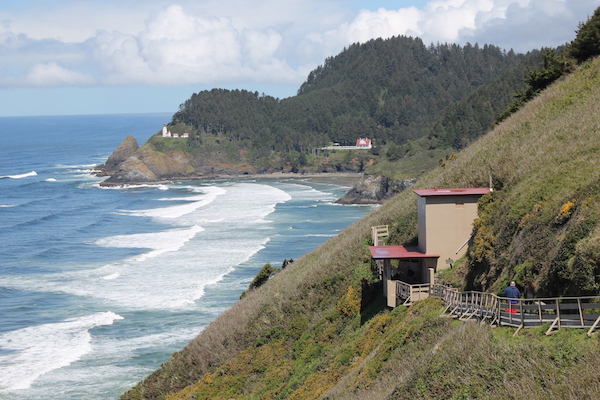Follow Highway 101 eleven miles north of downtown Florence, Oregon and you’ll find yourself on top of America’s largest sea lion cave.
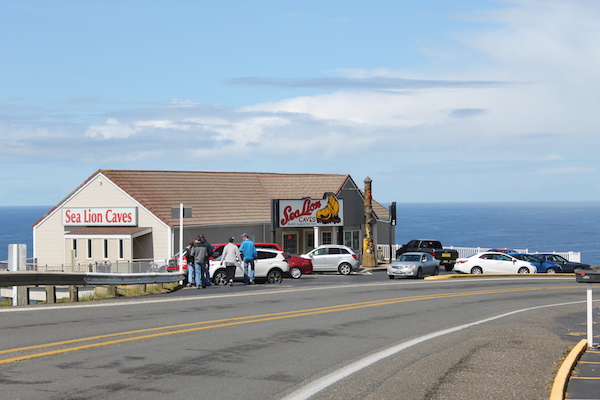 The site of Sea Lion Caves, a privately owned wildlife preserve and bird sanctuary, the caves are the year-round home to the Stellar sea lion, a near threatened species of sea lion that lives in the northern Pacific ocean.
The site of Sea Lion Caves, a privately owned wildlife preserve and bird sanctuary, the caves are the year-round home to the Stellar sea lion, a near threatened species of sea lion that lives in the northern Pacific ocean.
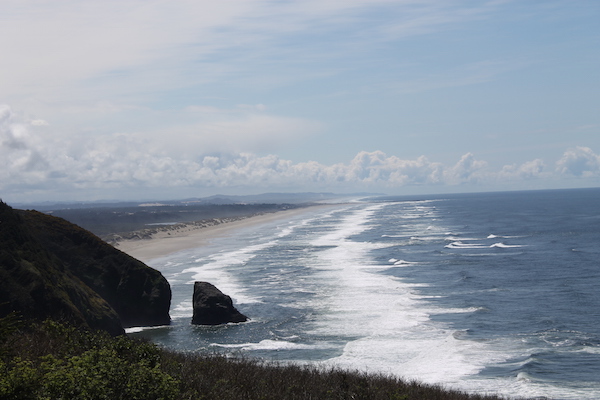 Owned and operated by the same family since 1932, Sea Lion Caves is not a zoo. The animals are protected, but they come and go and spotting a sea lion is not guaranteed (but in the winter months, the odds are in your favor).
Owned and operated by the same family since 1932, Sea Lion Caves is not a zoo. The animals are protected, but they come and go and spotting a sea lion is not guaranteed (but in the winter months, the odds are in your favor).
The cave itself has a two-acre floor area and a vaulted dome that is about 125 feet high. 1000 feet separate the rear of the main chamber to the sea level opening (which varies based on the tide).
Where to Stay
Find family-friendly accommodations in Florence, Oregon from traditional hotels to private vacation rentals through Stay22.com:
We visited the Sea Lion Caves in April, just missing the gray whale migration passing by Oregon on the way to Arctic feeding areas—as many as 16,000 gray whales make the journey each year, but you might see a mom and her calf who stayed to feed for the season.
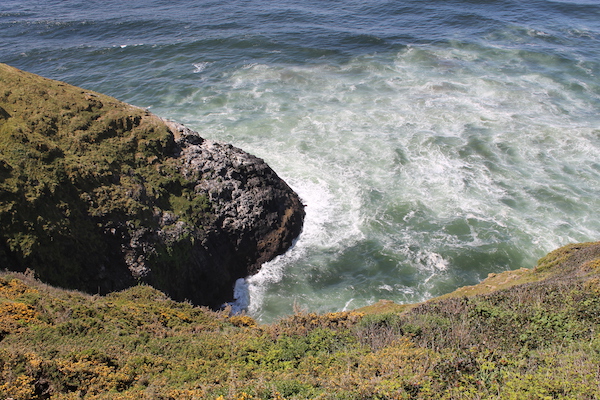 Open 363 days a year, Sea Lion Caves welcomes visitors between 9AM and 5PM (parking is located on both sides of 101 with overflow parking and plenty of room for busses and RVs). Adults pay $14, seniors pay $13, kids age 5-12 are $8, and kids four and under are free. We had a complimentary family pass, but would have otherwise spent $52 on just admission for our family of two adults and three kids.
Open 363 days a year, Sea Lion Caves welcomes visitors between 9AM and 5PM (parking is located on both sides of 101 with overflow parking and plenty of room for busses and RVs). Adults pay $14, seniors pay $13, kids age 5-12 are $8, and kids four and under are free. We had a complimentary family pass, but would have otherwise spent $52 on just admission for our family of two adults and three kids.
The visit entails a walk down stairs and a sloped, paved, walkway to an elevator that descends twelve stories down to just above the cave floor. While you walk, look for sea lions feeding and playing in the surf as well as the aforementioned whales.
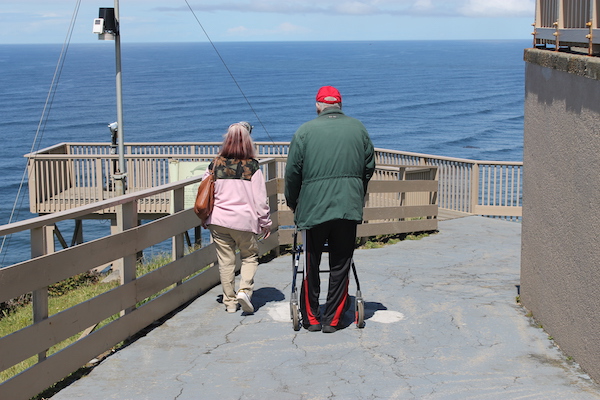 One of the main reasons for our visit was to scope out the location in advance of coming back with a grannie in tow. Fortunately, we were able to witness a senior citizen easily maneuver the steps and 10-20% grade (read the accessibility paragraph here)
One of the main reasons for our visit was to scope out the location in advance of coming back with a grannie in tow. Fortunately, we were able to witness a senior citizen easily maneuver the steps and 10-20% grade (read the accessibility paragraph here)
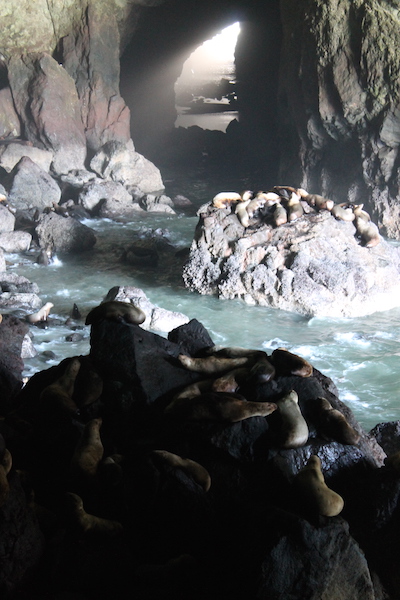 Now, as you might expect, the sea lion caves basically smell like sea lions and dead fish. The scent was manageable, but if you are pregnant and prone to morning sickness, consider this my PSA. The viewing area consists of a two-level tiered platform behind a wire barricade (protecting man from animal, and vice versa). Flash photography is not prohibited. The sea lions were plentiful and loud during our visit –the experience is fairly awesome.
Now, as you might expect, the sea lion caves basically smell like sea lions and dead fish. The scent was manageable, but if you are pregnant and prone to morning sickness, consider this my PSA. The viewing area consists of a two-level tiered platform behind a wire barricade (protecting man from animal, and vice versa). Flash photography is not prohibited. The sea lions were plentiful and loud during our visit –the experience is fairly awesome.
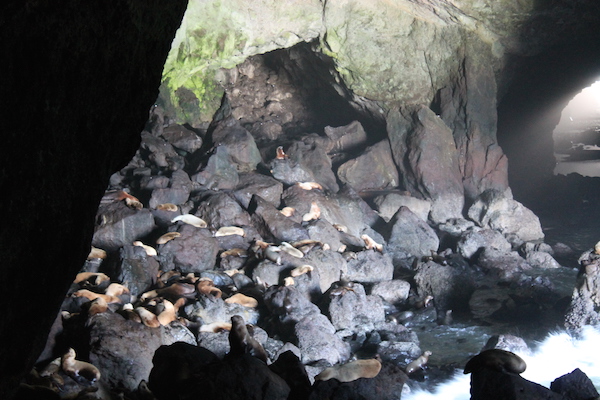 We did not watch the six minute video on the subjects of sea lions and how the cave was formed (mostly because the small theater was already full and six minutes of peace is too much to ask when you have elementary-age boys).
We did not watch the six minute video on the subjects of sea lions and how the cave was formed (mostly because the small theater was already full and six minutes of peace is too much to ask when you have elementary-age boys).
 In the opposite direction of the viewing area, visitors are welcome to climb 63 wooden steps to the location of the original (pre-elevator) cave entrance. In the distance you may see Heceta Head Lighthouse, one of the most photographed lighthouses in America. During our visit, the stairs were slick and water was dripping on us from the cave ceiling.
In the opposite direction of the viewing area, visitors are welcome to climb 63 wooden steps to the location of the original (pre-elevator) cave entrance. In the distance you may see Heceta Head Lighthouse, one of the most photographed lighthouses in America. During our visit, the stairs were slick and water was dripping on us from the cave ceiling.
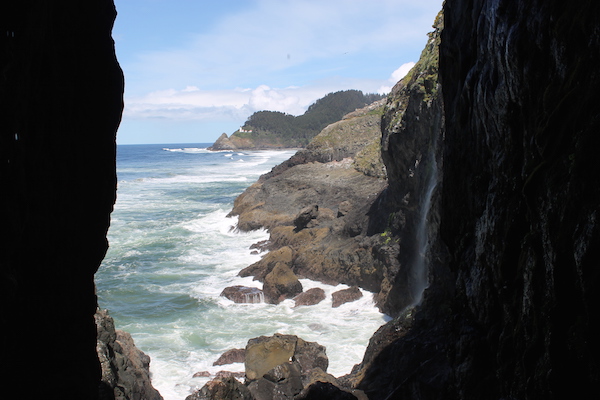 After a short wait for the elevator (there’s only one and a line can form in both directions) we reversed the journey to the gift shop. Truly a highlight of our visit was purchasing popcorn for $2 a bag; popcorn is allowed down in the caves but we opted to keep the mess in our car. Otherwise, you can find books, stuffed animals, magnets, and typical souvenirs.
After a short wait for the elevator (there’s only one and a line can form in both directions) we reversed the journey to the gift shop. Truly a highlight of our visit was purchasing popcorn for $2 a bag; popcorn is allowed down in the caves but we opted to keep the mess in our car. Otherwise, you can find books, stuffed animals, magnets, and typical souvenirs.
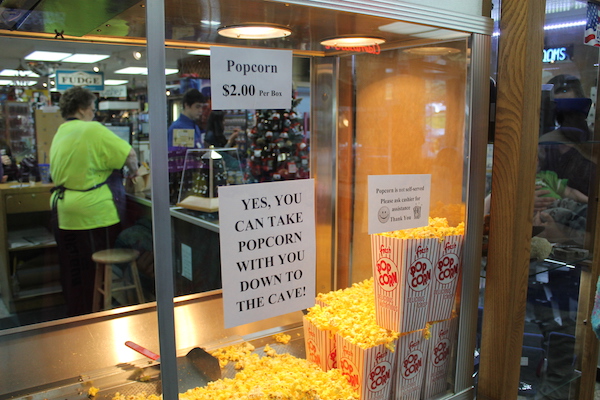 In general, we enjoyed our visit to Sea Lion Caves and are glad to cross the experience off our Oregon travel bucket list. For our family, the only downside was the admission cost versus the overall length of time spent observing the sea lions.
In general, we enjoyed our visit to Sea Lion Caves and are glad to cross the experience off our Oregon travel bucket list. For our family, the only downside was the admission cost versus the overall length of time spent observing the sea lions.

